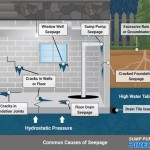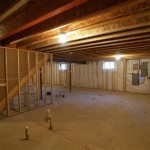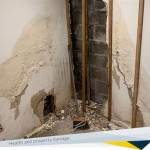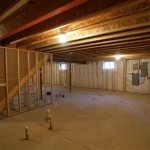Water Coming In Basement Walls: Essential Aspects
Water intrusion through basement walls is a common problem faced by homeowners, leading to costly repairs and potential damage to the property. Understanding the underlying causes and essential aspects of this issue is crucial for effective prevention and remediation.
Causes of Water Infiltration
Several factors can contribute to water infiltration through basement walls:
- Hydrostatic Pressure: When the water table rises above the basement floor level, it exerts pressure against the walls, forcing water through cracks or gaps.
- Foundation Settlement: Shifting or settling of the foundation can create gaps and cracks, allowing water to seep in.
- Poor Drainage: Inadequate or clogged gutters and downspouts can direct water towards the foundation, saturating the soil and increasing hydrostatic pressure.
- Cracks and Holes: Existing cracks or holes in the walls provide entry points for water.
- Condensation: High humidity levels in the basement can lead to condensation on the walls, resulting in water accumulation.
Consequences of Water Intrusion
Unresolved water infiltration can have severe consequences:
- Structural Damage: Water can weaken the foundation and walls, leading to cracks, bowing, and potential collapse.
- Mold and Mildew Growth: Damp environments foster the growth of mold and mildew, posing health risks and damaging flooring and furniture.
- Efflorescence and Staining: Excess moisture can cause efflorescence (white or chalky deposits) and staining on walls and floors.
- Electrical Hazards: Water can damage electrical wiring and outlets, creating safety hazards.
- Increased Energy Costs: Wet basements require more energy to heat and cool, resulting in higher utility bills.
Prevention and Remediation
Addressing water coming in basement walls requires a multifaceted approach:
- Exterior Waterproofing: Installing a waterproofing membrane on the exterior walls prevents water from penetrating the foundation.
- Interior Waterproofing: Applying a waterproof coating or installing a french drain on the interior walls diverts water away from the basement.
- Improve Drainage: Ensure gutters and downspouts are clean and functioning properly to redirect water away from the foundation.
- Seal Cracks and Holes: Repair any cracks or holes in the walls to prevent water seepage.
- Control Humidity: Use a dehumidifier to reduce moisture levels in the basement.
Professional Assistance
If self-help measures fail to resolve the issue, it is advisable to seek professional assistance from a licensed contractor. They can assess the damage, determine the root cause, and recommend the most effective waterproofing solution based on the specific conditions of your home.
Remember, prompt attention to water coming in basement walls is crucial to minimize the potential damage and safeguard your property.

Repairing Leaking Basement Walls What Works And Doesn T Work For Wall Leak Repairs

Wet Basement Diy Repair Guide Radonseal

Top Causes Of Water Seepage And Basement Leaks

Wet Basement Walls Causes Solutions Acculevel

Help My Basement Leaks When It Rains News And Events For Systems Inc

Get To Know How A Leaky Basement Can Ruin Your Home

Waterproofing Basement Walls Dos And Don Ts To Remember Bob Vila

What Causes Water To Leak Into A Basement News And Events For Terrafirma

Why Is Water Coming In Basement Where Walls Meet Floor

Basement Water Seepage Causes Prevention Mt Drains







